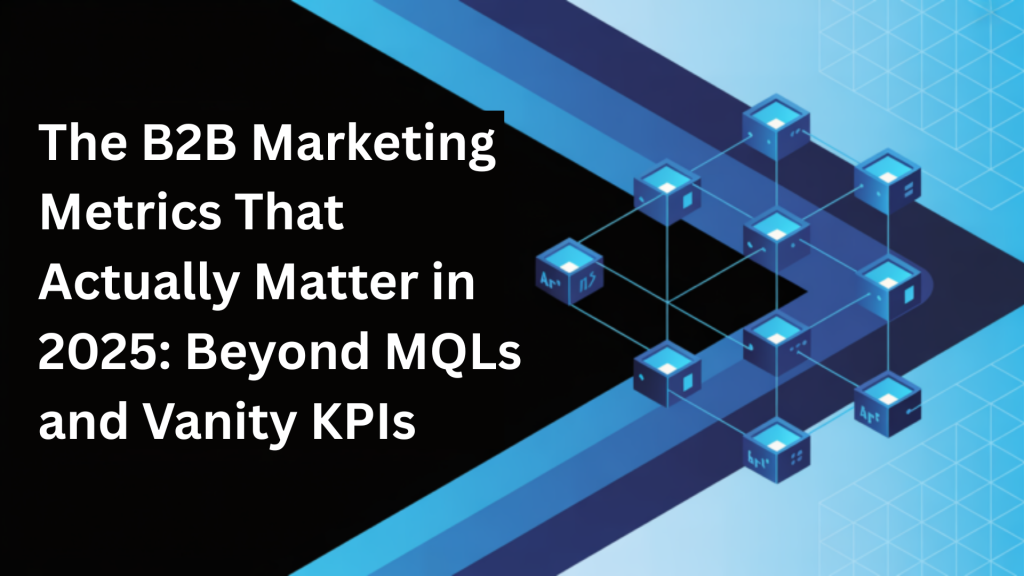Why B2B Marketing Metrics Must Evolve in 2025 –
In 2025, the role of a B2B marketer has dramatically evolved. It’s no longer enough to generate leads and hand them over to sales — marketing is now expected to contribute directly to pipeline and revenue. However, many teams are still relying on outdated metrics like MQLs, open rates, and social followers to measure performance. These vanity KPIs often paint an incomplete or misleading picture of impact, especially in long B2B buying cycles.
Instead of focusing on surface-level numbers, marketing leaders must align with sales and finance on business outcomes. This means shifting from measuring activity to measuring influence and outcomes. Marketers need to prove not just that people are seeing content, but that those interactions are leading to real revenue opportunities.
What’s wrong with traditional KPIs:
- MQLs often lack buying intent or sales-readiness
- High web traffic doesn’t mean high-quality engagement
- Email open rates are inflated due to privacy updates
Focus on Pipeline, Not Just Leads –
The most successful B2B marketing teams in 2025 measure their performance based on the pipeline they generate — not just the leads they collect. Why? Because a lead means very little unless it turns into a sales-qualified opportunity. Pipeline contribution is a clear, revenue-linked metric that ties marketing directly to business growth.
This shift requires proper tracking, attribution models, and close collaboration with sales. With multi-touch journeys being the norm in B2B, it’s critical to understand which campaigns and content pieces are actually moving prospects forward — and contributing to qualified pipeline.
Key pipeline-centric metrics to track:
- Marketing-Sourced Pipeline: Opportunities that originated from marketing efforts
- Marketing-Influenced Pipeline: Deals touched by marketing at any stage
- Pipeline Velocity: Speed at which deals move through the funnel
Revenue Efficiency Metrics Are the New Gold Standard –
Marketers in 2025 are expected to do more with less. As budgets tighten, executives want to know: how much does it cost to acquire a customer, and how long until we break even? Efficiency metrics like Customer Acquisition Cost (CAC) and Customer Lifetime Value (CLV) have become essential.
By comparing CAC to CLV, businesses can determine the sustainability of their marketing efforts. It also helps marketers identify which segments or channels bring the highest return. Tracking these metrics over time can reveal inefficiencies in the funnel, allowing for smarter investment decisions.
Essential efficiency metrics in B2B:
- CAC (Customer Acquisition Cost): Total spend divided by new customers acquired
- CLV (Customer Lifetime Value): Projected revenue from a customer over time
- CAC Payback Period: How long it takes to recover acquisition costs
Engagement Quality Over Engagement Quantity –
In B2B marketing, attention is easy to capture — but hard to keep. High page views or email opens don’t necessarily mean meaningful interest. That’s why in 2025, marketers are focusing on engagement quality, especially among high-value target accounts.
With tools like ABM platforms and intent data providers, it’s now possible to track how deeply key accounts are interacting with your content. It’s no longer about “how many” clicked — but who clicked, how long they stayed, and how often they came back. These behavioral insights are far more predictive of deal progression than simple vanity metrics.
Engagement quality signals to prioritize:
- Repeat visits from target accounts
- Time spent on product or pricing pages
- Content engagement by buying committee members
Attribution and Alignment –
Tracking the right metrics means little without the ability to attribute value and align with sales teams. In 2025, attribution models have become more advanced, moving beyond first- or last-touch to multi-touch and even algorithmic models. Marketers must understand which content or campaigns influenced each stage of the buying journey — not just the final conversion.
Equally important is alignment with sales. When both teams agree on what success looks like, collaboration improves. Marketing can create better content for deal acceleration, while sales can give better feedback on lead quality. Ultimately, this alignment ensures that marketing isn’t just a lead generator — it’s a full partner in revenue generation.
How to strengthen attribution and alignment:
- Adopt multi-touch attribution tools (e.g., Bizible, HubSpot, Dreamdata)
- Run regular pipeline reviews with sales
- Create shared dashboards with revenue-focused KPIs
Conclusion –
The B2B marketing world in 2025 is more data-driven and accountable than ever before. Vanity metrics no longer impress leadership — and they shouldn’t impress marketers either. To lead in today’s environment, marketers must embrace metrics that reflect true business impact: pipeline, revenue, efficiency, and engagement depth.
Marketing is no longer about generating random leads — it’s about contributing measurable value to the business. The sooner B2B teams adopt this mindset, the faster they’ll move from being seen as cost centers to being recognized as growth drivers.

